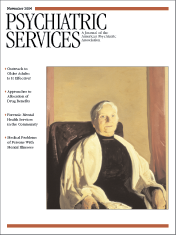Mental Health Outreach Services for Older Adults
Mental illness is underrecognized and undertreated among older adults. Outreach services have been promoted nationwide as a means of improving access and mental health outcomes in this population. However, evaluation of such services among older persons has been limited. Aricca D. Van Citters, B.A., and Stephen J. Bartels, M.D., M.S., conducted a literature review to examine evidence for effectiveness of psychiatric outreach to older adults in noninstitutional settings. Their goal was to determine whether geriatric mental health outreach services improve access to mental health care by identifying isolated older adults and whether such services lead to better psychiatric outcomes (see page 1237).
General Medical Problems Among Psychiatric Patients
Four papers in this issue address the important topic of co-occurring general medical problems that affect the quality of life of people who are in treatment for mental and substance use disorders. In the first paper, Danson R. Jones, Ph.D., and colleagues note that persons with serious mental illness tend to be in poorer physical health than those who are not mentally ill. These authors examined the prevalence, severity, and co-occurrence of chronic general medical problems among persons with serious mental illness (see page 1250). In another study, Kimber P. Richter, Ph.D., M.P.H., and colleagues, determined the prevalence and types of nicotine dependence services offered in methadone treatment clinics in the United States (see page 1258). On a similar theme, Judith J. Prochaska, Ph.D., M.P.H., and her coauthors examined delivery of tobacco cessation services in a smoke-free inpatient psychiatric setting (see page 1265). Finally, in a brief report, Faith B. Dickerson, M.D., Ph.D., and her colleagues address the important issue of sexual and reproductive behaviors of persons with mental illness (see page 1299).
How Should the Psychiatric Drug Benefit Be Managed?
The topic of how to properly manage the psychiatric drug benefit in large public or private health plans is addressed in three columns this month. Two Best Practices columns present very different approaches to allocating the drug benefit. In the first of these, Joseph Parks, M.D., and Richard Surles, Ph.D., describe a quality assurance strategy that was adopted by Missouri's Department of Mental Health to manage costs of the state's Medicaid pharmacy benefit (see page 1227). In the second column, Steve Morgan, Ph.D., and colleagues present a contrasting approach, explaining how provincial regulators in British Columbia, Canada, have collaborated with academia to define a formulary based on evidence of effectiveness (see page 1230). And in the Managed Care column, Diane Gottlieb, M.D., and her colleagues share the experiences of a committee of the Southeastern Pennsylvania Medicaid program that works with HMOs and community psychiatrists to maintain medication availability in the face of financial constraints (see page 1210).
The Emergence of Forensic Mental Health Services
Two articles in this issue address mental health services for clients who have been involved with the criminal justice system. In the first, J. Steven Lamberti, M.D., and colleagues present the results of a national survey of assertive community treatment programs to identify programs that have been modified to prevent arrest and incarceration of adults with severe mental illness. They describe forensic assertive community treatment (FACT) as an emerging model (see page 1285). Another group of researchers—Rajesh Mohan, M.R.C.Psych., and his colleagues, who are from the United Kingdom—conducted a literature review to establish clear definitions of community forensic mental health services, the characteristics of which have thus far been poorly defined (see page 1294).
Aspects of Psychiatric Inpatient Care
Four brief reports in this issue examine various aspects of psychiatric inpatient care. Christopher G. Hudson, Ph.D., examines trends in acute inpatient care in Massachusetts from 1994 to 2000. His results suggest that hospitals have not kept up with the increasing demand for inpatient psychiatric services (see page 1302). In another study, Jung-Chen Chang, R.N., Ph.D., and Chau-Shoun Lee, M.D., Ph.D., examined risk factors for aggressive behavior among 111 psychiatric inpatients in Taiwan (see page 1305). A study by Brent B. Benda, Ph.D., used life-course theory of readmission to examine outcomes of more than 600 homeless veterans admitted to a Department of Veterans Affairs inpatient program for patients with co-occurring disorders (see page 1308). Finally, Ali None Khadivi, Ph.D., and colleagues examined whether reducing the use of seclusion and restraint had an effect on violence among inpatients (see page 1311).



